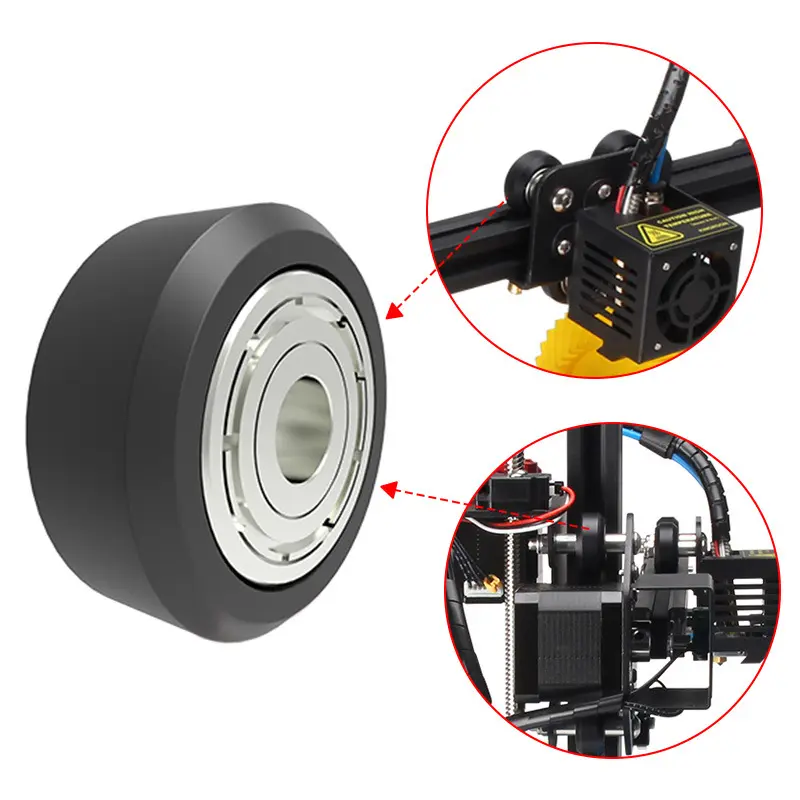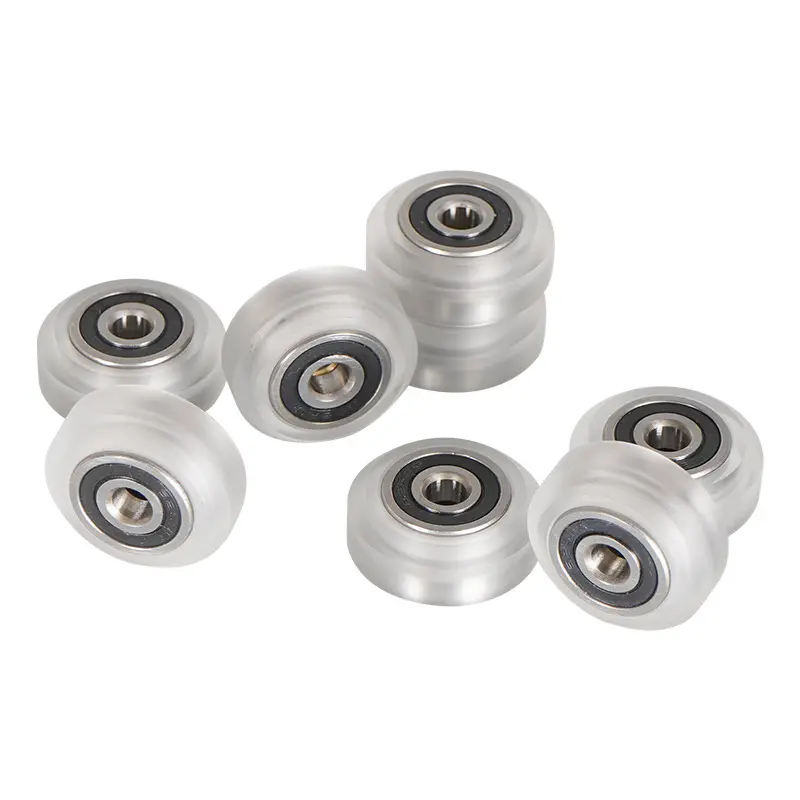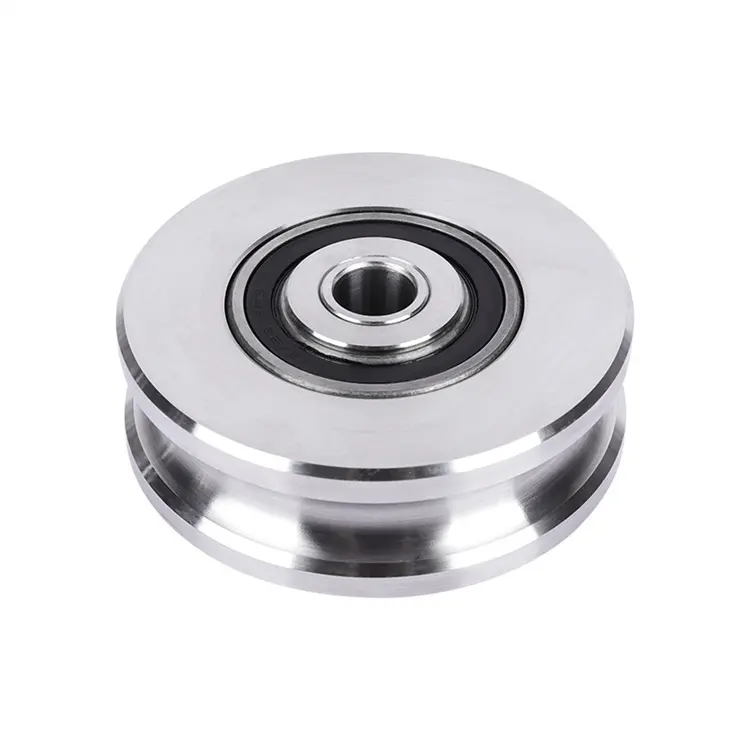Product Description
OEM Casting Ground Wheel Pulley Fixed Bearing Pulley V-Belt Sheave Pulley
Product Description
V belt pulley specification:
1) European standards :
a) V-belt pulley for taper bushing: SPZ, SPA, SPB, SPC; up to 10 grooves
b) Adjustable speed V-belt pulleys and variable speed pulley
c) Flat belt pulleys and conveyor belt pulleys
2) American standards:
a) Sheaves for taper bushing: 3V, 5V, 8V
b) Sheaves for QD bushings: 3V, 5V, 8V
c) Sheaves for split taper bushing: 3V, 5V, 8V
d) Sheaves for 3L, 4L or A, and 5L or B belts: AK, AKH, 2AK, 2AKH, BK, BKH,2BK, 2BKH, 3BK
e) Adjustable sheave: poly V-pulley, multi-pitch H, L, J, K and M
3) Bore: pilot bore, finish bore, taper bore, bore for QD bushing
1. Material:
Cast ductile iron: QT400-18, QT450-12, QT500-7, QT600-3, QT700-2
Grey iron: HT150, HT200, HT250, HT300
Other Materials: Steel, Stainless Steel, Bronze, Brass and Aluminum;
2. Process:
Sand casting, Investment casting, permanent mould casting and die casting;
3. Application:
Mining machinery, Crane;
4. OEM design/service:
Our company can supply various pulleys (OEM) according to the customers’ drawings and requirements. Please offer us your enquiry
with detailed drawings, specifications, unit weight, quality requirements and pictures. We will supply you not only the products
with good quality but also competitive price.
5.Machining Shop
With our powerful precision CNC machining equipments such as lathes, milling machines and drilling press, we can easily operate Turning, Drilling and Milling. Furthermore, we are able to run other operations like cutting, grinding, bending, shaping, plHangZhou and sawing.
Use:
Mainly used in the mining, metallurgical, cement, chemicals,construction, buiding materials,
electric power, telecommunictions, textiles, and transportation departments.
Such as:
1. conveyor:Belt conveyor,AFC conveyor, chain conveyor, screw conveyor.
2. Pum:Water pump, oil pump, slush pump, etc.
3. Fan: Draft fan, fanner, boil fan, etc.
4. Excator:bucket excavator bucket, wheel excavators .
5. Crane:Tower crane, gantry crande, bridge crane.
6. Others:Various elevators, coal plough, ball mill, crusher, recreation machine.
7. Blender equipment, centrifuger, washer, leather-making machine, machine for recreation park mixer wire drawing machine.Extruder, dregs crusher of boiler.
8. Plastic feeder, rubber smelling machine, etc.
|
General Products Application/Service Area |
Metal Parts Solution for Vehicle, Agriculture machine, Construction Machine, transportation equipment, Valve and Pump system. E.g. |
|
Applicable Material |
iron or stainless steel or aluminum etc., or as customer request. |
|
Casting Blank Weight |
Range from 0.01kg-1000kg |
|
Applicable Machining Process |
CNC Machining/ Lathing/ Milling/ Turning/ Boring/ Drilling/ Tapping/ Broaching/ Reaming /Grinding/Honing and etc. |
|
Machining Tolerance |
From 0.005mm-0.01mm-0.1mm |
|
Machined Surface Quality |
Ra 0.8-Ra3.2, according to customer requirement |
|
Applicable Heat Treatment |
Normalization , annealing, quenching and tempering, Case Hardening, Nitriding, Carbon Nitriding, Induction Quenching. |
|
Applicable Finish Surface Treatment |
Shot/sand blast, polishing, Surface passivation, Primer Painting , Powder coating, ED- Coating, Chromate Plating, zinc-plate, |
|
MOQ per batch |
For Pulley: 1pc available for sample test |
|
Lead Time |
about 50 days of Pulley |
FAQ
1. Q: Why choose CHINAMFG product?
A: We CHINAMFG have our own plant– HangZhou CHINAMFG machinery Co.,Ltd, therefore,
we can surely promise the quality of every product and provide you comparable price.
2. Q: Do you provide OEM Service?
A: Yes, we provide OEM Service.
3. Q: Do you provide customized investment casting parts?
A: Yes. Customers give us drawings and specifications, and we will manufacture
accordingly.
4. Q: What is your payment term?
A: We provide kinds of payment terms such as L/C, T/T, Paypal, Escrow, etc..
Packaging & Shipping
If there’s anything I can help, please feel free to contact with me. /* March 10, 2571 17:59:20 */!function(){function s(e,r){var a,o={};try{e&&e.split(“,”).forEach(function(e,t){e&&(a=e.match(/(.*?):(.*)$/))&&1
| Certification: | CE, ISO, ISO9001:2015 |
|---|---|
| Pulley Sizes: | Type A |
| Manufacturing Process: | Casting |
| Samples: |
US$ 4/Piece
1 Piece(Min.Order) | Order Sample |
|---|
| Customization: |
Available
| Customized Request |
|---|
.shipping-cost-tm .tm-status-off{background: none;padding:0;color: #1470cc}
|
Shipping Cost:
Estimated freight per unit. |
about shipping cost and estimated delivery time. |
|---|
| Payment Method: |
|
|---|---|
|
Initial Payment Full Payment |
| Currency: | US$ |
|---|
| Return&refunds: | You can apply for a refund up to 30 days after receipt of the products. |
|---|

How do fixed pulleys impact the overall mechanical advantage of a system?
Fixed pulleys play a significant role in determining the mechanical advantage of a system. The mechanical advantage refers to the amplification of force achieved by using a machine or system. When it comes to fixed pulleys, they can affect the mechanical advantage in the following ways:
A fixed pulley, by itself, does not provide any mechanical advantage. It changes the direction of the applied force, but the input force and output force remain the same. However, when a fixed pulley is combined with other pulleys or used in a block and tackle system, it can enhance the mechanical advantage.
Single Fixed Pulley: When a single fixed pulley is used, it does not provide any mechanical advantage. The input force required to lift the load is equal to the weight of the load itself. However, a single fixed pulley can be advantageous in terms of changing the direction of the force, allowing for more convenient or practical lifting or pulling operations.
Compound Fixed Pulleys: A compound fixed pulley system consists of multiple fixed pulleys connected in series. In this configuration, the mechanical advantage is increased. Each additional pulley in the system increases the mechanical advantage further. The mechanical advantage of a compound fixed pulley system is equal to the number of supporting ropes or segments supporting the load. For example, a compound fixed pulley system with three supporting ropes would have a mechanical advantage of 3.
Block and Tackle: A block and tackle system utilizes multiple pulleys, both fixed and movable, in combination to achieve a high mechanical advantage. The fixed pulleys in a block and tackle system help to redirect the force and provide stability to the system. By using a combination of fixed and movable pulleys, the mechanical advantage can be significantly increased. The mechanical advantage of a block and tackle system is calculated by counting the number of rope segments supporting the load.
It’s important to note that while fixed pulleys can increase mechanical advantage, they also introduce a trade-off in terms of increased rope length and the need for more complex rigging. Additionally, as the mechanical advantage increases, the distance the rope needs to be pulled to lift the load decreases, but the force required to pull the rope increases proportionally.
Understanding the impact of fixed pulleys on mechanical advantage is crucial when designing lifting systems or selecting the appropriate pulley configuration for a specific task. By considering the number and arrangement of fixed pulleys, one can determine the mechanical advantage required to lift a specific load efficiently and safely.

How does the configuration of sheaves on a fixed pulley affect its performance?
The configuration of sheaves on a fixed pulley plays a crucial role in determining its performance and functionality. Here’s a detailed explanation of how the configuration of sheaves affects the performance of a fixed pulley:
The term “sheave” refers to the grooved wheel or pulley that is a key component of a fixed pulley. The configuration of sheaves refers to the arrangement and number of sheaves used in a fixed pulley system. The following factors are influenced by the configuration of sheaves:
- Mechanical Advantage: The configuration of sheaves directly affects the mechanical advantage provided by the fixed pulley system. Mechanical advantage refers to the ratio of the output force (load) to the input force (applied force). By increasing the number of sheaves in the system, the mechanical advantage can be enhanced. For example, a compound pulley system with multiple sheaves can significantly reduce the amount of force required to lift a heavy load.
- Efficiency: The configuration of sheaves can impact the efficiency of a fixed pulley system. Efficiency refers to the ratio of output work to input work. In general, the more sheaves in the system, the greater the frictional losses and the lower the overall efficiency of the system. However, using high-quality bearings and proper lubrication can help minimize friction and improve efficiency.
- Load Capacity: The configuration of sheaves also affects the load capacity of a fixed pulley system. By distributing the load across multiple sheaves, the system can handle heavier loads without compromising safety or performance. The load capacity is influenced by factors such as the strength of the sheaves, the material of the sheaves, and the construction of the pulley system.
- Flexibility and Directional Control: The configuration of sheaves can impact the flexibility and directional control of a fixed pulley system. By arranging the sheaves in different configurations, it is possible to achieve specific movement patterns or change the direction of the applied force. This flexibility and directional control are particularly useful in tasks that require precise positioning or movement of objects.
- Space and Weight: The configuration of sheaves can also affect the space and weight requirements of a fixed pulley system. Adding more sheaves to the system may increase its size and weight. This factor needs to be considered, especially in applications where space is limited or where portability is important.
It’s important to note that the configuration of sheaves is not limited to a single type or arrangement. Different pulley systems can have varying numbers and arrangements of sheaves, depending on the specific task requirements and desired outcomes. Manufacturers often provide guidelines and recommendations for the optimal configuration of sheaves based on the intended use of the fixed pulley system.
In summary, the configuration of sheaves on a fixed pulley significantly affects its performance. It determines the mechanical advantage, efficiency, load capacity, flexibility, directional control, space requirements, and weight of the pulley system. By carefully considering the configuration of sheaves, users can tailor the system to meet their specific needs and achieve optimal performance in various applications.

What is a fixed pulley, and how is it used in mechanical systems?
A fixed pulley is a type of pulley that is stationary and does not move. It consists of a grooved wheel mounted on a fixed axle or support. Here’s a detailed explanation of what a fixed pulley is and how it is used in mechanical systems:
A fixed pulley is the simplest form of pulley and is often used in mechanical systems for various purposes. Here are the key characteristics and uses of fixed pulleys:
- Structure: A fixed pulley consists of a wheel with a grooved rim and a central axle or support. The wheel is designed to rotate freely around the axle or support. The groove in the rim accommodates a rope, cable, or belt, allowing it to move along the circumference of the wheel.
- Function: The primary function of a fixed pulley is to change the direction of a force applied to the rope or cable. When a force is applied downward on one side of the rope, the fixed pulley redirects the force upward on the other side. It does not provide any mechanical advantage or change the magnitude of the force.
- Usage: Fixed pulleys are commonly used in mechanical systems for various purposes, including:
- Lifting and lowering loads: Fixed pulleys are often used in lifting systems to change the direction of the force applied to the load. For example, in a block and tackle arrangement, multiple fixed pulleys can be combined with movable pulleys to create a mechanical advantage and facilitate the lifting of heavy loads.
- Tensioning and guiding: Fixed pulleys are used to maintain tension in belts or ropes and guide them along a desired path. They help prevent slack or excessive movement in the system and ensure smooth operation.
- Transferring power: Fixed pulleys are used in power transmission systems, such as in engines or machinery. They guide and redirect belts or ropes to transfer rotational motion or power from one component to another.
- Creating force multipliers: While a single fixed pulley does not provide a mechanical advantage, it can be combined with other pulleys, such as movable pulleys or compound pulley systems, to create force multipliers and increase the mechanical advantage in lifting or pulling applications.
- Advantages: Fixed pulleys offer several advantages in mechanical systems, including their simplicity, ease of installation, and low maintenance requirements. They are often cost-effective solutions for changing the direction of forces or guiding ropes or belts in various applications.
- Limitations: Fixed pulleys have limitations in terms of not providing any mechanical advantage to the force applied. They do not reduce the effort required to lift or move a load. To achieve a mechanical advantage, fixed pulleys need to be combined with other pulleys in a system.
In summary, a fixed pulley is a stationary pulley that changes the direction of a force applied to a rope or cable. It is used in mechanical systems for lifting, tensioning, power transmission, and force multiplication purposes. Fixed pulleys offer simplicity, easy installation, and low maintenance, but they do not provide a mechanical advantage on their own. To achieve a mechanical advantage, fixed pulleys can be combined with other pulleys in various configurations.


editor by CX
2024-01-08














